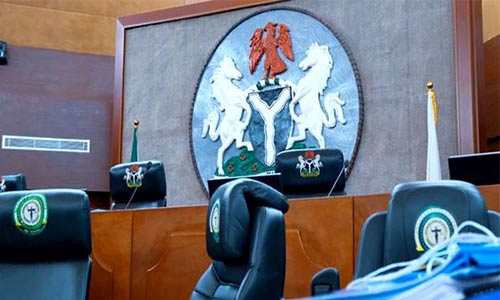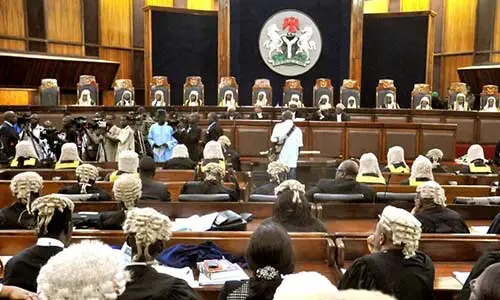SUPREME COURT JUDGEMENTS 10/01/2023
When Court Can Order Pleadings In Action Commenced By Originating Summons

In the Supreme Court of Nigeria
Holden at Abuja
On Friday, the 2nd day of December, 2022
Before Their Lordships
Kudirat Motonmori Olatokunbo Kekere-Ekun
Uwani Musa Abba Aji
Mohammed Lawal Garba
Helen Moronkeji Ogunwumiju
Adamu Jauro
Justices, Supreme Court
SC/349/2011
Between
1. LADY LEADER BASILIA EKANEM
2. PROPHETESS FORTUNE HART
3. SNR. ELDER GEOFFREY MAMA APPELLANTS
And
1. THE REGISTERED TRUSTEES OF THE
CHURCH OF CHRIST THE GOOD SHEPHERD
2. EMMANUEL O. ALOZIE
3. CORPORATE AFFAIRS COMMISSION RESPONDENTS
(Lead Judgement delivered by Honourable Mohammed Lawal Garba, JSC)
Facts
The Appellants commenced an action against the Respondents at Federal High Court, Calabar Judicial Division, by way of Originating Summons in which they sought inter alia, a declaration that the 1st Respondent’s constitution which ought to have been submitted by the 2nd Respondent for the purpose of registering the 1st Respondent with the 3rd Respondent, ought to be a certain 2003 constitution and not the 2005 constitution. They Appellants alleged that the 2nd Respondent concealed the existence of the 2003 constitution which was the only constitution ratified at the National Convention of the 1st Respondent, from the 3rd Respondent. The case of the Appellants was that they are members of the Church of Christ the Good Shepherd, and they found out that the 2nd Respondent who is the Most Senior Apostle and General Overseer of the 1st Respondent, used the 2005 constitution which was not approved at the National Convention of the Church to register the Church with the 3rd Respondent. They claimed that their interests under the 2003 Constitution were compromised in the 2005 Constitution, and the same was being used by the 2nd Respondent to harass and intimidate the Appellants.
The 1st and 2nd Respondent filed a Counter-Affidavit and raised a Preliminary Objection, challenging the locus standi of the Appellants to maintain the suit and the mode of commencement of the suit. The 1st and 2nd Respondent maintained that the Church’s 2003 resolution (Exhibit E1) had been amended in February 2005 and upon its amendment, it was printed and signed by the 2nd Respondent as the General Overseer of the Church and the 1st Appellant’s husband – Snr. Evangelist Promise E. Ekanem, the Secretary of the Church. They claimed that further to the agreement of the members of the Church, the 2nd Respondent approached the 3rd Respondent to use the said February 2005 Constitution for the registration of the Church, and the staff of the 3rd Respondent observed that the signatures on the February 2005 Constitution was wrongly arranged. They posited that though being a minor mistake, it did not affect the registration process; however, the 2nd Respondent was advised to correct the placement of the signatures, and the Church upon being notified about this recommendation effected the correction in May 2005, after which the corrected Constitution was sent to the 3rd Respondent. It was also their case that while registering the Church, a Notice of Objection was published and when there was no objection to the registration; thus, the Church of Christ the Good Shepherd was accordingly registered. And, to keep the records of the Church straight, the February 2005 Constitution was discarded, leaving the Constitution as corrected in May 2005 (Exhibit E2) as the operative and binding Constitution of the Church. They maintained that Exhibits E1 and E2 were identical in every particular, except in the arrangement of the signature. They further claimed that the Appellants, without reason, stopped worshipping with the Church, and proceeded to form their own church – Church of Christ the Good Shepherded in 2008 and having left the Church in the circumstances in which they did, the Appellants do not and should not have any dealings with the Church.
The trial court in its judgement held that the Appellants failed to show that they have the locus standi to maintain the action, and struck out the suit. Aggrieved, the Appellants filed an appeal to the Court of Appeal, which court set aside the decision of the trial court, and held that the Appellants have the requisite locus standi to institute the action at the trial court. The Court of Appeal ordered that a fresh hearing of the suit be conducted after filing and exchange of pleadings among the parties. Still dissatisfied, the Appellants appealed to the Supreme Court.
Issues for Determination
The Apex Court considered the following issues in its determination of the appeal:
1. Whether the learned Justices of the Court of Appeal ought to have heard the Appellants’ case on the merit.
2. Whether the Court of Appeal was right to have ordered pleadings to be filed and exchanged in the circumstances of this case.
Arguments
On the first issue, counsel for the Appellants submitted that the Court of Appeal ought to have invoked Section 15 of the Court of Appeal Act to look into the case as if it is a court of first instance and resolve the issues, rather than remitting the same back to the trial court. He invited the Supreme Court to invoke its powers under Section 22 of the Supreme Court Act, to look at the circumstances and materials in the Appellant’s case and decide it on the merit. On the second issue, counsel for the Appellants argued that there was no need for the order made by the court below for the filing of pleadings in the suit, because the contents of Exhibits E1 and E2 (the 2003 and 2005 Constitutions of the 1st Respondent) are clear and un-ambiguous and are documents regulated by the provisions of Section 128(i) of the Evidence Act which do not require pleadings and evidence to prove. Relying on PAM v MOHAMMED (2008) 16 NWLR (Pt. 1112) 1 at 88, counsel argued that the suit was rightly commenced by Originating Summons procedure.
Responding on the first issue, respective counsel for the 1st and 2nd Respondent argued similarly that, Section 15 of the Court of Appeal Act, 2004 does not make it mandatory for the Court of Appeal to determine the case of the Appellants as if it is a court of first instance. They submitted that the referenced Section 15 of the Court of Appeal Act gives the Court of Appeal the liberty to rehear the case in whole or in part, or remit it to the trial court. Counsel for the 1st Respondent argued that since the Court of Appeal decided the issue of locus standi of the Appellants to institute the action which was the basis upon which the trial court struck out the suit, it could not have decided the matter on the merit under Section 15 of the Court of Appeal Act. Both counsel submitted that the decision of the Court of Appeal remitting the case back to the trial court for fresh hearing is proper, by virtue of Section 15 of the Court of Appeal Act. On the second issue, both argued that, in view of the contradictory affidavit evidence between the parties, the Court of Appeal was right to have ordered a fresh trial on pleadings and evidence to resolve the conflict, particularly on the allegation of fraud raised therein. They submitted that the Appellants’ suit involves contentious issues, which can only be determined by filing of pleadings.
The 3rd Defendant did not file any process or participate in the appeal even though it was duly served with all the material processes of the appeal including hearing notices.
Court’s Judgement and Rationale
In deciding the first issue in the appeal, the Supreme Court held that it is not in doubt that the Court of Appeal has wide powers under Section 15 of the Court of Appeal Act to assume the same position as a trial court to determine an action; however, certain conditions must be present to warrant the exercise of these powers of the Court of Appeal. The necessary conditions which the Court of Appeal would consider before it can invoke these powers are (a) The question must be a ground of appeal (b) The trial court must have jurisdiction on same; (c) All the necessary materials needed to determine the merits of the claim must be before the court; (d) The length of time between the disposal of the action at the trial court and the hearing of the appeal; (e) The court would consider the hardship or injustice that would follow, if the case is remitted to the trial court.
The Supreme Court held that these conditions were obviously not present, since the Court of Appeal could not, as the trial court, have determined the facts by merely considering the conflicting affidavit evidence of the parties. The only course open to the Court of Appeal was thus, to send it back to the trial court for trial on pleadings.
On the second issue, the Supreme Court held that the use of Originating Summons to commence a legal action is resorted to, where the rights claimed or reliefs sought are predicated on the interpretation or construction of documents, agreements, contracts, statutes and other instruments, or where material facts are not in dispute or likely to be in serious dispute between the parties – KEYAMO v HOUSE OF ASSEMBLY, LAGOS STATE (2002) 12 SC (Pt. I) 190. It follows therefore that, where material facts are not only in serious but riotous dispute between parties, an Originating Summons would neither be appropriate, proper nor suitable for the commencement of an action, since oral evidence may be required for the resolution of the dispute. The court placed reliance on DOHERTY v DOHERTY (1967) ALL NLR, 245 and FAMFA OIL LTD v A-G FEDERATION (2003) 18 NWLR (Pt. 852) 453.
Their Lordships held further that from the affidavit evidence of parties before the court and exhibits annexed thereto, the relevant and material facts relied on by the parties in support of their respective position on the authority and validity of the constitution of the 1st Respondent are not only in dispute, but seriously so, with the allegation of concealment with intention to deceive, which constitutes an allegation of fraud. With the allegation of fraud in the affidavit evidence before the trial court, there was the need to call oral evidence in order to prove same in accordance with the standard required and prescribed by law; beyond reasonable doubt. That standard cannot be met on affidavit evidence alone, which cannot be tested under cross-examination for its credibility, and what the law mandates is that, where the court is of the view that a case cannot properly be tried by originating summons, parties should be ordered to file pleadings. The Court of Appeal was thus right, to have ordered a re-trial of the case after the filing and exchange of pleadings.
Appeal Dismissed.
Representation
A. S. Abdulkadir, Esq. for the Appellants.
Folashade Alli, Esq. with Umar Saka, Esq. for the 1st Respondent.
S. B. Joseph (Jnr.) for the 2nd Respondent.
Olivia Agbajo, Esq. for the 3rd Respondent.


